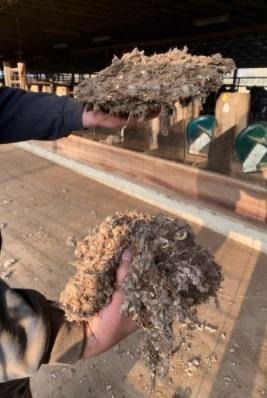In order to limit fat intake, the general daily recommended feeding rate of whole cottonseed in growing cattle is 0.33% of the animal’s body weight. Cattle consuming the DeltaPine variety consumed close to this level (0.39% of animal body weight), whereas those on the ultra-low gossypol variety reached almost twice the recommended level of intake (0.78% of animal body weight). Animals consuming the ultra-low gosspyol variety exceeded recommended daily fat intake levels, but those on the DeltaPine variety did not.
This information demonstrates that whole cottonseed consumption may be influenced by cotton variety or gossypol levels. However, cottonseed sourced from gins will consist of a mixture of seed from various commercially available cotton varieties. One of the main foundations of whole cottonseed feeding recommendations is fat. Results from this study indicate that feeding levels of 0.33% of animal body weight for growing beef cattle is still appropriate to keep fat intake within the recommended range.
How does cotton gin trash processing influence feed value and animal performance?

Baled Gin Trash
Cotton gin trash, sometimes called cotton gin byproduct, is composed of lint, burs, stems, cottonseed, and seed fragments. Traditionally, gin trash is stacked in large piles outside of a cotton ginning facility, and is a low bulk density feed. This feed source is used as a roughage replacement in beef cattle diets. Gin trash feed value is roughly equivalent to a low to mid-quality hay. Some cotton gins have invested in equipment to pack gin trash into 550 to 600 pound rectangular bales. Baled gin trash can be stored out of the weather and eases transportation by enabling a producer to haul gin trash in smaller loads.
Based on feed samples of loose and baled gin trash, nutritional value can vary between these forms. A feed intake trial was conducted with dry, pregnant beef cattle to determine overall intake and performance when fed loose or baled gin trash. Cows consumed 2.0% of their body weight per day of loose trash, and 1.8% of their body weight per day in baled gin trash. This is equivalent to expected daily dry matter intake of cattle of similar size and production stage (~2.0% of animal body weight).
Nutritional value of gin trash used in the trial is presented in table 1, which illustrates that energy value (TDN) of gin trash is low, but moderate protein value (CP) is provided. In this study, cows were fed 4 pounds per head daily of a 50/50 soyhulls and corn gluten feed supplement to help meet nutritional demands. All cows maintained a body condition score of 5 or greater in the study and gained weight during the trial. This information demonstrates that baled or loose gin trash may be used as an alternative roughage source and can support dry cow performance with appropriate supplementation. When developing feeding plans with gin trash, a feed quality analysis is important to determine the amount of supplementation required to meet animal needs.
Table 1. Nutritional Value of Gin Trash
Source : aces.edu